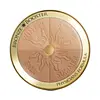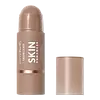Physician's Formula Glow-Boosting Season-to-Season Bronzer Versus Covergirl Trublend Skin Enhancer Balm Contour Stick
What's inside
What's inside
 Key Ingredients
Key Ingredients

 Benefits
Benefits

 Concerns
Concerns

 Ingredients Side-by-side
Ingredients Side-by-side

Mica
Cosmetic ColorantDiisostearyl Malate
EmollientSynthetic Wax
AbrasiveNylon-12
Ethylhexyl Palmitate
EmollientPolybutene
Lauroyl Lysine
Skin ConditioningDimethicone
EmollientDimethicone/Methicone Copolymer
Inositol
HumectantMaltodextrin
AbsorbentMucuna Pruriens Seed Extract
AstringentKaolin
AbrasiveOctyldodecyl Stearoyl Stearate
EmollientCaprylyl Glycol
EmollientPhenethyl Alcohol
MaskingIron Oxides
Synthetic Fluorphlogopite
Tin Oxide
AbrasiveTitanium Dioxide
Cosmetic ColorantCI 19140
Cosmetic ColorantMica, Diisostearyl Malate, Synthetic Wax, Nylon-12, Ethylhexyl Palmitate, Polybutene, Lauroyl Lysine, Dimethicone, Dimethicone/Methicone Copolymer, Inositol, Maltodextrin, Mucuna Pruriens Seed Extract, Kaolin, Octyldodecyl Stearoyl Stearate, Caprylyl Glycol, Phenethyl Alcohol, Iron Oxides, Synthetic Fluorphlogopite, Tin Oxide, Titanium Dioxide, CI 19140
Caprylic/Capric Triglyceride
MaskingIsostearyl Neopentanoate
EmollientMica
Cosmetic ColorantPolyethylene
AbrasiveSynthetic Fluorphlogopite
Simmondsia Chinensis Seed Oil
EmollientKaolin
AbrasiveDicalcium Phosphate
AbrasiveSynthetic Beeswax
Emulsion StabilisingSynthetic Wax
AbrasiveAluminum Hydroxide
EmollientStearalkonium Bentonite
Gel FormingCalcium Sodium Borosilicate
Polyhydroxystearic Acid
EmulsifyingSilica
AbrasivePropylene Carbonate
SolventPentaerythrityl Tetra-Di-T-Butyl Hydroxyhydrocinnamate
AntioxidantPunica Granatum Pericarp Extract
Skin ConditioningTin Oxide
AbrasiveRubus Idaeus Leaf Extract
Skin ConditioningVitis Vinifera Fruit Extract
Skin ConditioningIron Oxides
CI 77891
Cosmetic ColorantCI 42090
Cosmetic ColorantCI 15985
Cosmetic ColorantCI 45410
Cosmetic ColorantCI 15850
Cosmetic ColorantCI 19140
Cosmetic ColorantCaprylic/Capric Triglyceride, Isostearyl Neopentanoate, Mica, Polyethylene, Synthetic Fluorphlogopite, Simmondsia Chinensis Seed Oil, Kaolin, Dicalcium Phosphate, Synthetic Beeswax, Synthetic Wax, Aluminum Hydroxide, Stearalkonium Bentonite, Calcium Sodium Borosilicate, Polyhydroxystearic Acid, Silica, Propylene Carbonate, Pentaerythrityl Tetra-Di-T-Butyl Hydroxyhydrocinnamate, Punica Granatum Pericarp Extract, Tin Oxide, Rubus Idaeus Leaf Extract, Vitis Vinifera Fruit Extract, Iron Oxides, CI 77891, CI 42090, CI 15985, CI 45410, CI 15850, CI 19140
Ingredients Explained
These ingredients are found in both products.
Ingredients higher up in an ingredient list are typically present in a larger amount.
CI 19140 is also known as Tartrazine. Tartrazine is a synthetic dye used in cosmetics, foods, and medicine to add a yellow color.
Tartrazine is created from petroleum and is water-soluble.
Some people may experience allergies from this dye, especially asthmatics and those with an aspirin intolerance.
Learn more about CI 19140Kaolin is a clay. It is used for oil control and to help minimize pores. Like other clays, kaolin has the ability to absorb excess sebum or oil. This can help clean out pores and mattify the skin.
Some types of kaolin may have exfoliating properties. When water is added to kaolin, it becomes a paste with small abrasive particles.
Most kaolin is a white color, but may be pink/orange/red depending on where it comes from.
The name 'kaolin' comes from a Chinese village named 'Gaoling'. Kaolin clay comes from rocks rich in kaolinite. Kaolinite, the mineral, has a silicate layered structure. Kaolinite is formed from chemical weathering of aluminum siilicate minerals.
Besides skincare, kaolin is commonly used to make glossy paper, in ceramics, toothpaste, and as medicine to soothe stomach issues.
Learn more about KaolinMica is a naturally occurring mineral used to add shimmer and color in cosmetics. It can also help improve the texture of a product or give it an opaque, white/silver color.
Serecite is the name for very fine but ragged grains of mica.
This ingredient is often coated with metal oxides like titanium dioxide. Trace amounts of heavy metals may be found in mica, but these metals are not harmful in our personal products.
Mica has been used since prehistoric times throughout the world. Ancient Egyptian, Indian, Greek, Roman, Aztec, and Chinese civilizations have used mica.
Learn more about MicaSynthetic Fluorphlogopite is the synthethic version of mica. It consists of fluorine, aluminum and silicate.
Synthetic Fluorphlogopite is used to add volume to products.
It is considered non-irritating on the skin.
Learn more about Synthetic FluorphlogopiteSynthetic Wax is created from fossil fuels such as natural gas. It is used to enhance texture, adjust pH, and as an occlusive.
It may also be used as an abrasive ingredient to exfoliate the skin.
Synthetic Wax may not be fungal acne safe.
Learn more about Synthetic WaxTin Oxide is an inorganic oxide used to add opacity and volume to a product. In nature, it is already found in mineral form. The main ore of tin is an opaque and shiny mineral called casseterite.
Tin Oxide helps remove translucency in a product, or make it more opaque. Besides adding opacity, tin oxide is used for bulking to add volume.
This ingredient is a combination of red, black, and yellow iron oxide pigments. This combination of colors is usually found in foundation, because it results in a "skin" color.